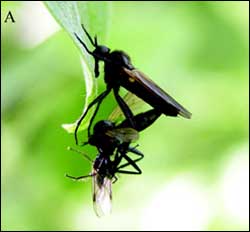An invasion of cheats: The evolution of worthless nuptial gifts

So-called nuptial gifts – often consisting of food or tokens – are typically bestowed by males on females as part of courtship and copulation rituals in many species. By manipulating the nuptial gifts that female insects receive during copulation, researchers have now shown that female preferences can be exploited by males who are “cheating” on their reproductive investment by presenting easily obtainable token gifts.
Gift-giving during courtship and copulation occurs across the animal kingdom, including in humans. Nuptial gifts can range from valuable nutritious food items to inedible tokens such as leaves or silk balloons. Gift-giving is of clear benefit to females when gifts are nutritious and thus valuable, but why females of some species require an inedible and worthless gift remains unexplained. In experiments reported this week, researchers Natasha LeBas and Leon Hockham from the University of St. Andrews removed the valuable (i.e., edible) nuptial gift that male empidid dance flies normally provide their female partner and replaced the gift with either a large edible gift or an inedible cotton ball token that resembles tokens given by other empidid fly species. The researchers found that although pairs copulated longest after presentation of a large edible gift, the females receiving the worthless cotton ball token were sufficiently tricked to allow males to copulate for as long as when the males provided a small nutritious gift. Males who substitute highly visible, but easily obtainable and worthless gifts may thus be able to invade a population of genuine gift-giving males.
The research demonstrates that, at least in some cases, females are susceptible to the invasion of so-called male cheating behaviour, and it suggests that the evolution of worthless gift-giving may arise though males’ sensory exploitation of female preferences for nutritious gifts.
Natasha R. LeBas and Leon R. Hockham: “An Invasion of Cheats: The Evolution of Worthless Nuptial Gifts”
Media Contact
All latest news from the category: Life Sciences and Chemistry
Articles and reports from the Life Sciences and chemistry area deal with applied and basic research into modern biology, chemistry and human medicine.
Valuable information can be found on a range of life sciences fields including bacteriology, biochemistry, bionics, bioinformatics, biophysics, biotechnology, genetics, geobotany, human biology, marine biology, microbiology, molecular biology, cellular biology, zoology, bioinorganic chemistry, microchemistry and environmental chemistry.
Newest articles

Properties of new materials for microchips
… can now be measured well. Reseachers of Delft University of Technology demonstrated measuring performance properties of ultrathin silicon membranes. Making ever smaller and more powerful chips requires new ultrathin…

Floating solar’s potential
… to support sustainable development by addressing climate, water, and energy goals holistically. A new study published this week in Nature Energy raises the potential for floating solar photovoltaics (FPV)…

Skyrmions move at record speeds
… a step towards the computing of the future. An international research team led by scientists from the CNRS1 has discovered that the magnetic nanobubbles2 known as skyrmions can be…





















